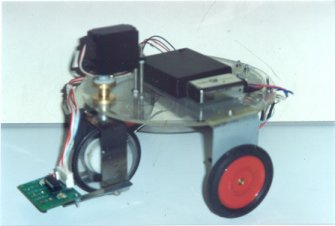Experiences With The Lynxmotion Line Tracker Kit


Having just finished my hexapod robot and before progressing to a more advanced model with jointed legs,
I decided I would like to try my hand at a wheeled robot.
I made up a robot platform to experiment with and to try different
sensors on, etc. I had the ultimate view of making a complete wheeled
Robot, maybe even Fire Fighter. As the platform used a single wheel
drive, I decided to fit a line following device as my first accessery
so I could see how it would steer.
I bought a Lynxmotion line-following kit from OZ Robotics.
The kit is very simple, and consists of a PCB, three IR
emitter/detectors, six resistors, a 74HC14 Schmidt inverter chip, along
with a 5 volt regulator. Even as a newbie, I thought there would be no
problems setting it up! After assembly I made a frame to fit in front
of the wheel to carry the unit. When everything was mounted and the
sensors set 0.25 inches (6mm) above the ground as recommended, I
started to check out the operation and found the IRD outputs were
5volts when they should have been zero. After checking the outputs a
couple of times with no joy, I dismantled the PCB and rebuilt the unit.
I did this three times and every time the IRDs would not switch off!
Frustrated with the thing I left it for the weekend.
On Monday morning I cranked it up again, and low-and-behold the darn thing worked perfectly! I had another job to do, so when I
returned I turned on the workshop lights and switched the unit on. I couldn’t believe it - the 5 volts were back!
I then realized what the problem was - the IRDs were picking up the workshop lights.
I had no further trouble, except that I had broken one of the leads on one of the IR detectors. I e-mailed
OZ Robotics for a replacement, but they didn’t have one. OZ Robotics contacted
Lynxmotion for a replacement, but they wanted to keep the stock they had for future kits - not so good
I thought.
After reading through some catalogues I located an IR detector that
appeared to be the same size, since I couldn’t find out any specs from OZ Robotics for the original
one. I purchased three and replaced the one with the broken lead. It
worked much better than the original, as it detected the line further
from the floor and didn’t appear to be affected as much by the workshop
lights.
So another newbie has learnt a lesson the hard way!
After programming the stamp with the supplied demo program, I placed
the robot on a white board with a line of black insulating tape. I
switched it on and away it went, following the line without any
trouble. If it varied a bit to either side of the line it would find it
OK.
If the robot wandered too far off, it would spin in all directions
looking for the line. Sometimes it would cross the line without
sucessfully
finding it. The program needs to have quite a bit added to it, to make
the robot find the line more efficiently.
I thought the cost was reasonable for somebody to get started, even
though I wasn't able to buy replacement parts.
The replacement IR detector I used was made by Kondenshi (think that how you spell it) model no SG-2BC.
Editors note: US residents can purchase this kit directly from Lynxmotion for $20USD.
New Zealand or Australian residents would be better off getting it from Oz Robotics.
Thanks for helping to keep our community civil!
This post is an advertisement, or vandalism. It is not useful or relevant to the current topic.
You flagged this as spam. Undo flag.Flag Post


